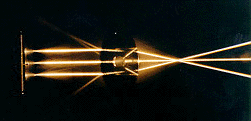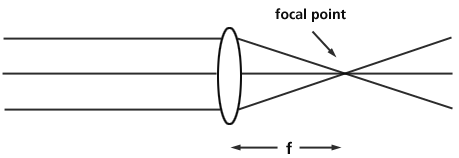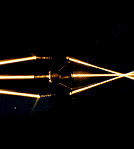
The Focal Length, or Frying an Ant on the Sidewalk
We use lenses and mirrors everyday but sometimes don't really understand how and why they do what they do. In this section of the Readings, we'll learn a little more about how light interacts with such things as lenses and how this interaction can help us.Most optical elements (mirrors, lenses) can be characterized by basically one quantity: their focal length. To understand focal length, we need to know something about the focal point.

In the image above, note how the light rays, after they pass through the lens, converge on a single point. Below is a schematic drawing of the above situation.

The single point to which the light rays are converging is called the focal point. The distance, f, from the lens to the focal point is the focal length. Each lens and mirror has its own focal length, which is its defining characteristic.
Note, however, that in showing the focal length of the lens above, we used light rays that were all parallel as they came to the lens. This isn't always the case: we can have light rays incident at different angles.

In the case above, the focal point is farther from the lens, because the incident rays were diverging as they came to the lens.
What would happen if the rays were already converging as they hit the lens? Where would we find the focal length in that case?
So when we discuss the "focal length" of a certain lens or mirror, we are usually referring to the focal length you get when a distant object's light rays (parallel light) are incident on the lens or mirror.
To find out the difference between Real and Virtual Images, go on to the Second Part of these Readings.
Page authored by the
ACEPT W3 Group
Department of Physics and Astronomy, Arizona State University, Tempe, AZ 85287-1504
Copyright © 1995-2000 Arizona Board of Regents. All rights reserved.